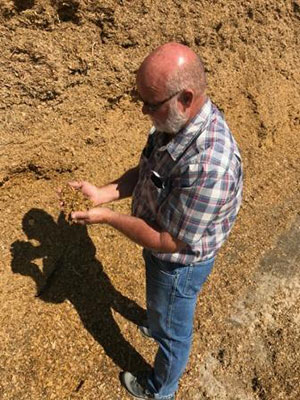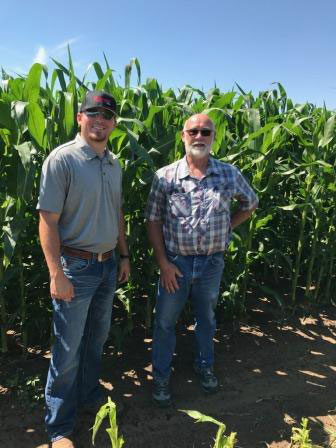Mycogen Seeds Awards Year of Forage Testing to Silage Corn Grower |
|
Mycogen Seeds dairy development manager Jim Henry and Silage Testing Sweepstakes winner Ed Hilger discuss the importance of silage quality on Hilger’s farm in Ulysses, Kansas. |
This item has been supplied by a forage marketer and has not been edited, verified or endorsed by Hay & Forage Grower.  Mycogen Seeds winner Ed Hilger examines his corn silage. Ed Hilger, a silage corn grower from Ulysses, Kansas, has won a year of free silage testing courtesy of Mycogen Seeds. The Mycogen Seeds Silage Testing Sweepstakes was one way the team at Mycogen demonstrates the importance of testing to properly track the quality and composition of silage. “Producers and corn silage growers need the ability to understand silage quality with testing both at harvest and before feeding,” says Jim Henry, western dairy development manager for Mycogen Seeds. “We partner with farmers to decode their silage composition through testing. That gives them a clearer picture of their feeding program to build the best ration possible for their herds.” Hilger grows 6,000 acres of corn that is used as silage, earlage or high-moisture corn for a large scale dairy in southwestern Kansas.  Mycogen Seeds dairy development manager Jim Henry and Silage Testing Sweepstakes winner Ed Hilger discuss the importance of silage quality on Hilger’s farm in Ulysses, Kansas. “We need to know what makes that cow happy,” Hilger says. “The only way we can do that is testing our silage and knowing how to use the product when it comes out of storage.” Hilger uses testing data to evaluate the starch and fiber content as well as the digestibility of his corn silage hybrids. With results in hand, he works with his teams at the dairy and Mycogen to produce a high-quality forage that meets the dairy’s needs. “Ed is one of my elite silage growers and he is constantly looking for the next best thing in quality and tonnage,” says Landon Lukens, sales representative for Mycogen Seeds. “Every hybrid is tested and evaluated as it is grown, harvested, stored and fed.” “Landon helps me throughout the year to analyze data we receive from testing and use it to make decisions or adjustments for the next year,” Hilger says. “That includes selecting the right hybrids for the right acres that will deliver a high-quality result.” Henry offers these harvest and silage testing best practices as producers near harvest and prepare to store and feed a new silage crop.
 Mycogen Seeds representative Landon Lukens visits with Ed Hilger to present one year of free silage testing. To learn more about Mycogen® brand corn silage hybrids, talk with your local representative or dealer, or visit Mycogen.com/Silage. About Mycogen Seeds Mycogen Seeds offers leading genetics in corn, soybeans, silage corn, sunflowers and canola. A seed company of Dow AgroSciences LLC, Mycogen Seeds maintains a robust global research and development program to bring growers high-performance genetics with the latest trait technologies. Mycogen Seeds is committed to helping growers be better acre after acre with dependable seed, smart ideas and hard work. For more information about Mycogen brand products, visit Mycogen.com or follow Mycogen Seeds on Facebook, Twitter and YouTube. About Dow AgroSciences Dow AgroSciences discovers, develops, and brings to market crop protection and plant biotechnology solutions for the growing world. Based in Indianapolis, Indiana, USA, Dow AgroSciences is a wholly owned subsidiary of The Dow Chemical Company and had annual global sales of $6.2 billion in 2016. Learn more at www.dowagro.com. Follow Dow AgroSciences on Facebook, Twitter, LinkedIn, and Google+, or subscribe to our News Release RSS Feed. |
